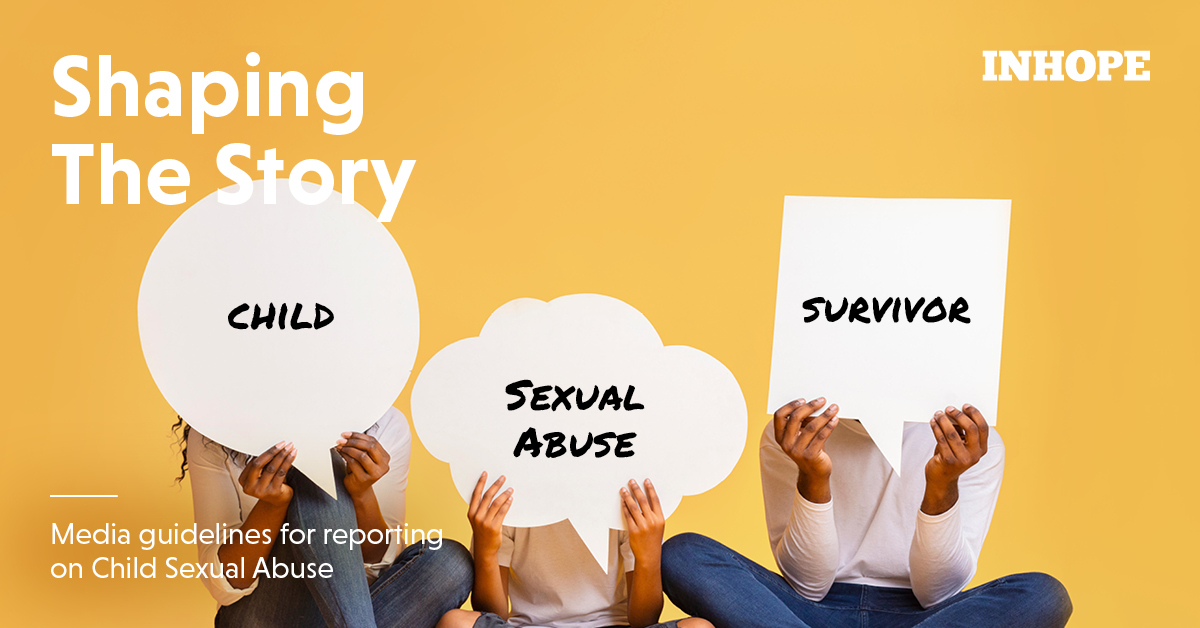Article
Events & Campaigns
Shaping the Story - Media Guidelines for Reporting on Child Sexual Abuse
Journalists have great power to bring public health issues such as Child Sexual Abuse (CSA) and Child Sexual Abuse Material (CSAM) into societal awareness. But with great power, comes great responsibility. We refreshed our campaign "Shaping the Story" to remind everyone that terminology and the way in which we frame stories of abuse, determine how this subject is perceived in society.
To ensure that our public response to CSAM, is appropriate, respectful and helpful we must continue to advocate that everyone involved follows the best practices outlined in our CSAM Media guidelines. Only by using harmonised terminology guidelines can we ensure that our approach to raising awareness and fighting CSAM is genuinely global. Not using a consistent structure in addressing this topic leads to miscommunication, and can complicate the harmonisation of legislation.
Promoting Prevention Instead of Fear
The crimes some children have to experience are unimaginable, but framing stories to evoke fear is not helpful. It does not support the victim nor create a clear picture of the wider societal issue. To avoid fearmongering, frame your story in a way that helps people form a clear picture of how and why children are suffering, and how adults can help. Providing solutions and helpful resources can give your story a more positive outlook. Learn how to avoid fearmongering here.
Thematic vs Episodic Storytelling
Both thematic and episodic storytelling has merit, but it is critical to find a balance. CSA is not isolated; reporting on individual cases also has to acknowledge the broader societal issue. While isolated stories can be impactful and empower survivors, always make sure to include contextual information. Read more here.
Tackling Stereotypes
Everyone can be a victim or survivor of sexual violence. While statistics show that some demographics are more vulnerable to abuse than others, anyone regardless of gender, societal background, race, religion or ethnicity can be targeted for abuse. Similarly, the same applies to offenders. We must remember that anyone regardless of age, gender or background can be a perpetrator. Learn how to tackle stereotypes in your reporting.
Sexual vs Factual Descriptions
When reporting cases of child sexual abuse (CSA) and child sexual abuse material (CSAM) avoid including graphic or sexualised descriptions. Graphic details do not benefit the survivor and might even lead to revictimization and re-traumatisation of the victim. Sticking to factual descriptions.
Attributing Responsibility to the Perpetrator
When reporting stories of abuse, the blame must always be on the perpetrator, not the victim. Make the offender the subject of sentences and the victim/survivor the object. This way you assign the responsibility to the perpetrator and not the child. Whether a victim was attractive, had previous sexual relations with the perpetrator, engaged in risky behaviour, dressed provocatively, or had a lot to drink, the responsibility and blame for a sexual assault lie with the person who perpetrated the offence. Read more.
Individual Issue vs. Societal Issue
Media outlets and journalists can help audiences understand that child abuse and neglect are not simply the result of individual failure or family dynamics but a public health issue. It is critical to provide relevant societal context and to promote prevention on a societal level. Learn which details are important.
Being Sensitive instead of Sensationalist
All sexual abuse is violent. Graphic details and descriptions of injuries do not add to the story and only revictimize the survivors. Do not sensationalise child sexual abuse as it distorts understanding of the broader issue, spreading fear without support or solution. How to avoid sensationalism.
A Balanced Story vs Victim Blaming
The language in your report on CSA should leave no room for interpretation on who is to blame for the abuse. It is always on the person who committed the crime, and never on the victim or survivor. Creating a balanced picture.
An Individual's Right to Privacy vs. Public Record
Even if some information may be accessible, that does not mean it should be publicised. Consider the impact on the victim before making any personal information about them public. Make sure to protect their privacy by not providing identifying features of the victim. This can make them more vulnerable to future victimization and create feelings of shame, which could impact recovery for the individual and discourage others from reporting cases. Learn which information should stay private.
Survivor vs. Victim
This use can vary, some people say that the term victim is more appropriate as they were the victim of a crime, while others have felt that survivor portrays who they are and do not see themselves as a victim. Be sensitive to this nuance as it changes from individual to individual. Learn which language to use.
Child Abuse Material vs Child Pornography
The term child pornography fails to describe the true nature of the material and undermines the seriousness of the abuse from the child’s perspective. Pornography is a term primarily used to describe material depicting adults engaged in consensual sexual acts distributed for the purposes of sexual pleasure. Using this term in the context of children risks normalizing, trivializing and even legitimizing sexual abuse and exploitation. The importance of appropriate terminology.
If you or your organisation covers any of the topics outlined above, you should download our CSAM Media guidelines that outline best practices in reporting on CSAM. Do you have any questions, or concerns or want to propose additions to these guidelines? You can contact us anytime at communications@inhope.org.
